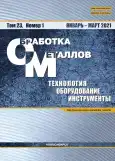Technology of obtaining composite conglomerate powders for plasma spraying of high-temperature protective coatings
- Authors: Guzanov B.N.1, Pugacheva N.B.1, Slukin E.Y.1, Bykova T.M.1
-
Affiliations:
- Issue: Vol 23, No 1 (2021)
- Pages: 6-20
- Section: TECHNOLOGY
- URL: https://bakhtiniada.ru/1994-6309/article/view/301929
- DOI: https://doi.org/10.17212/1994-6309-2021-23.1-6-20
- ID: 301929
Cite item
Abstract
Keywords
About the authors
B. N. Guzanov
Email: guzanov_bn@mail.ru
D.Sc. (Engineering), Professor, Russian State Vocational Pedagogical University, 11 Mashinostroiteley str., Ekaterinburg, 620012, Russian Federation, guzanov_bn@mail.ru
N. B. Pugacheva
Email: nat@imach.uran.ru
D.Sc. (Engineering), Associate Professor, Institute of Engineering Science, Ural Branch of Russian Academy of Sciences, 34 Komsomolskaya str., Ekaterinburg, 620049, Russian Federation, nat@imach.uran.ru
E. Yu. Slukin
Email: slukin@cniim-ekt.ru
Ph.D. (Engineering), Associate Professor, Ural Federal University named after the first President of Russia B.N. Yeltsin, 19 Mira str., Ekaterinburg, 620002, Russian Federation, slukin@cniim-ekt.ru
T. M. Bykova
Email: tatiana_8801@mail.ru
Ph.D. (Engineering), Institute of Engineering Science, Ural Branch of Russian Academy of Sciences, 34 Komsomolskaya str., Ekaterinburg, 620049, Russian Federation, tatiana_8801@mail.ru
References
- Rickerby D.S., Winstone M.R. Coatings for gas tyrbines // Journal of Manufacturing Processes. – 1992. – Vol. 7, iss. 4. – P. 485–526. – doi: 10.1080/10426919208947439.
- Burgel R. Coating service experience with industrial gas turbines // Journal of Materials Science and Technology. – 1986. – Vol. 2. – P. 302–308. – doi: 10.1179/mst.1986.2.3.302.
- Гузанов Б.Н., Косицын С.В., Пугачева Н.Б. Упрочняющие защитные покрытия в машиностроении. – Екатеринбург: УрО РАН, 2003. – 244 с. – ISBN 5-7691-1405-3.
- Chaki T.K., Singht A.K., Sadananda K. Effect of Co-Cr-Al-Y coating on microstructural stability and creep behavior of nickel-base superalloy // Thin Solid Films. – 1989. – Vol. 168. – P. 207–220. – doi: 10.1016/0040-6090(89)90007-2.
- Мубояджан С.А., Лесников В.П., Кузнецов В.П. Комплексные защитные покрытия турбинных лопаток авиационных ГТД. – Екатеринбург: Квист, 2008. – 208 с. – ISBN 5-900474-60-7.
- Газотермическое напыление композиционных порошков / А.Я. Кулик, Ю.С. Борисов, А.С. Мнухин, М.Д. Никитин. – Л.: Машиностроение, 1985. – 199 с.
- Uusitalo M.A., Vuristo P.M.J., Mantyla T.A. Elevated temperature erosion-corrosion of thermal sprayed coatings in chlorine containing environments // Wear. – 2002. – Vol. 252, iss. 7–8. – P. 586–594. – doi: 10.1016/S0043-1648(02)00014-5.
- Lai G.Y. High-temperature corrosion and materials application. – Materials Park, Ohio: ASM International, 2007. – 461 p. – ISBN 978-0-87170-853-3.
- Sidhu S.S., Prakash S. Performance of NiCrAlY, Ni-Cr, Stellite-6 and Ni3Al coatings in Na2SO4-60% V2O5 environment at 900° under cyclic conditions // Surface and Coatings Technology. – 2006. – Vol. 201, iss. 3–4. – P. 1643–1654. – doi: 10.1016/j.surfcoat.2006.02.035.
- Matthews S., Schweizer M. Optimization of arc-sprayed Ni-Cr-Ti coatings for high temperature corrosion applications // Journal of Thermal Spray Technology. – 2013. – Vol. 22, iss. 4. – P. 538–550. – doi: 10.1007/s11666-013-9914-y.
- Конгломерированные композиционные порошки для газотермического напыления / В.Р. Калиновский, Ю.В. Соколов, А.Ф. Ильющенко, В.В. Трощий, А.В. Калиновский // Перспективы развития поверхностного и объемного упрочнения сплавов: сборник научных трудов, посвященный 40-летию кафедры «Материаловедение в машиностроении» / под ред. Л.Г. Ворошина. – Минск, 2004. – С. 124–133.
- Ильинкова Т.А., Барсукова Е.А., Тагиров А.Т. Взаимосвязь характеристик порошковых материалов и механических свойств плазменных теплозащитных покрытий // Вестник технологического университета. – 2015. – Т. 18, № 15. – С. 116–121.
- Особенности структуры и свойств γ+β сплавов Ni-Cr-Al вблизи эвтектического состава / С.В. Косицын, Б.Н. Гузанов, С.Д. Алексин, А.А. Копылов // Физика металлов и металловедение. – 1990. – № 9. – С. 114–122.
- Tingaud D. Nardou F. Influence of non-reactive particles on the microstructure of NiAl and NiAl–ZrO2 processed by thermal explosion // Intermetallics. – 2008. – Vol. 16, iss. 5. – P. 732–737. – doi: 10.1016/j.intermet.2008.02.016.
- Пугачева Н.Б. Современные тенденции развития жаростойких покрытий на основе алюминидов железа, никеля и кобальта // Diagnostics, Resource and Mechanics of Materials and Structures. – 2015. – Iss. 3. – P. 51–82. – doi: 10.17804/2410-9908.2015.3.051-082. – URL: https://www.dream-journal.org/DREAM_Issue_3_2015_Pugacheva_N._B._051_082..pdf (дата обращения: 14.01.2021).
- Studying the structure and adhesion strength of thermal barriers coating / N.B. Pugacheva, B.N. Guzanov, N.V. Obabkov, T.M. Bykova, N.S. Michurov // AIP Conference Proceedings. – 2019. – Vol. 2176. – P. 030013-1–030013-4. – doi: 10.1063/1.5135137.
- Особенности создания комбинированных теплостойких покрытий для деталей высокотемпературного назначения / Б.Н. Гузанов, Н.Б. Пугачева, В.Д. Алексеев, Е.Ю. Слукин // Вестник ПНИПУ. Машиностроение, материаловедение. – 2020. – Т. 22, № 3. – С. 12–19. – doi: 10.15593/2224-9877/2020.3.02.
- Белопольский М.С. Сушка керамических суспензий в распылительных сушилках. – М.: Стройиздат, 1972. – 126 с.
- Поляков А.А., Круглицкий Н.Н. Распылительная сушка в технологии радиоэлектронных материалов. – М.: Радио и связь, 1982. – 70 с.
- Лыков М.М., Леончик Б.И. Распылительные сушилки. – М.: Машиностроение, 1966. – 331 с.
- Патент 3960545 США, МКИ В 22 F 9/00. Cermet plasma flame spray powder, method for producing same and articles produced the reform / Port D.J., Lafferty W.D., Cheney R.F. (USA); GTE Sylvania Incorporated (USA). – N 561638. – Publ. 01.06.1976.
- Патент 4025334 США, МКИ В 22 F 1/00, C 23 C 7/00. Tungsten carbide-cobalt flame spray powder and method / Cheney R.F., Lafferty W.D., Long G. (USA); GTE Sylvania Incorporated (USA). – N 674961. – Publ. 24.05.1977.
- Патент 3881911 США, МКИ С 22 C 1/04-1/05, С 04 B 35/52-35/38. Free flowing, sintered refractory agglomerates / Cheney R.F., Lafferty W.D., Long G. (USA); GTE Sylvania Incorporated (USA). – N 411663. – Publ. 06.05.1975.
- Stecura S. Effects of yttrium, aluminum and chromium concentrations in bond coatings on the performance of zirconia-yttria thermal barriers // Thin Solid Films. – 1980. – Vol. 73, iss. 2. – P. 481–489. – doi: 10.1016/0040-6090(80)90521-0.
- Mrdak M.R. Mechanical properties and metallographic analysis of plasma spray ABS – Ni5.5wt.%Al5wt.%Mo coatings // Vojnotehnicki glasnik / Militaru Technical Courier. – 2019. – Vol. 67, iss. 3. – P. 573– 587. – doi: 10.5937/vojtehg67-17424.
- Витман Л.А., Кацнельсон Б.Д., Палеев В.И. Распыливание жидкости форсунками. – М.: Госэнергоиздат, 1962. – 264 с.
Supplementary files






